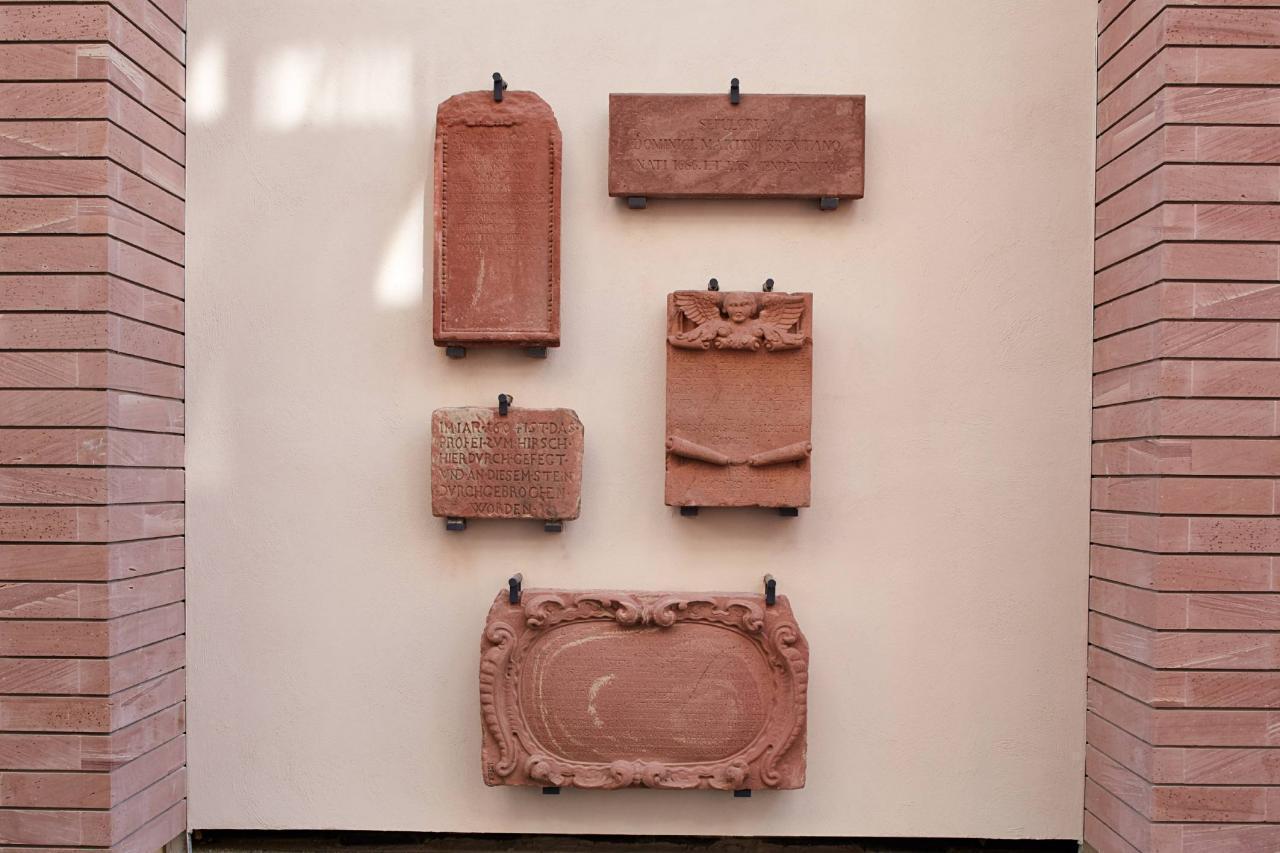Niche 6 - Grave and crypt slab
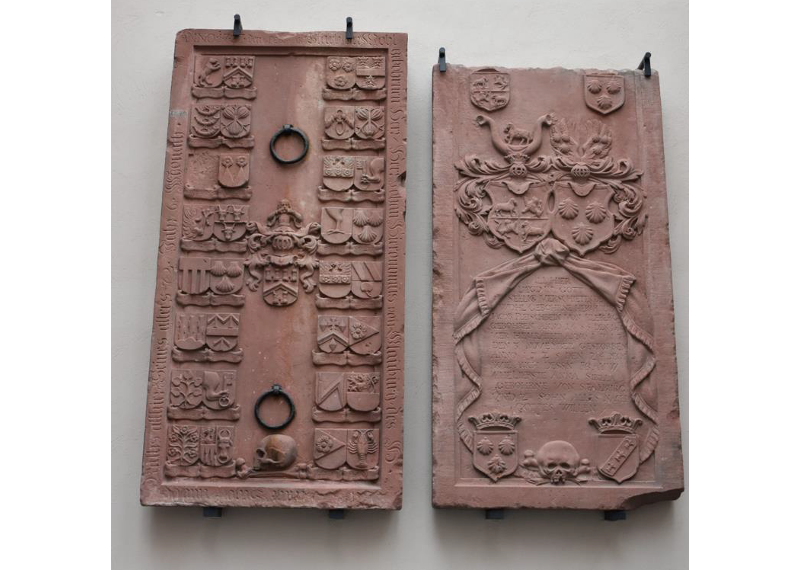
Tomb slab of Johann Hieronymus of Glauburg, 1727
Old Peterskirche
The rectangular tomb slab is made of red sandstone. In the middle it shows the coat of arms with crest of the Glauburg family. To the left and right of it are 16 inscribed coats of arms each. In the lower panel a skull and bones are depicted. The inscription running around the outer edge of the grave plate reads translated:
In the year 1727, February 6th, the well born Lord Johan Hieronimus of Glauburg, of the Kingdom
Schöff and of the
council here, his age 72 years, 6 month
Johann Hieronymus von Glauburg (1654-1727) bought the "Burg" in Niedererlenbach from the city council of Frankfurt in 1698. He was a councillor in 1704, Younger Mayor in 1713, Alderman in 1716, and in 1724 Elder Mayor of the City of Frankfurt am Main. These public offices are also mentioned on his gravestone.
On the slab you can see the so-called "Great ancestral testatment".
4 coats of arms - those of the grandparents
8 coats of arms - and those of great-grandparents
16 coats of arms - and those of great-great-grandparents
32 coats of arms - and those of great-great-great-grandparents
By placing these 32 coats of arms on the tomb slab, a long and continuous noble tradition of the family should be documented. One of the coats of arms was completely removed from the stone slab.
The family names on the slab are (from top left to bottom right):
Hörngen, Hornchin, Hörngin; Glauburg; Holzhausen; Fürstenberg
Geltaus v. d. junger Abend; Knoblauch; Rohrbach; Knoblauch
Gossembrot; Rehling; Weiß von Limpurg; Humbracht
Lauingen; Scheidler; Uffstein(er); Stalburg
Vom Rhein; Stalburg; Weiß von Limpurg; Pregler v. B(amberg)
Jostenhofer (?); Stralenberger; Neuhaus; Völcker
Märckel; Humbracht; Steffan; Mengershausen
Raiss; v. Hell (gen. Pfeffer); Völker; Melem
Gravestone, 1725
Base plate of a dwelling on the Zeil, original location unclear
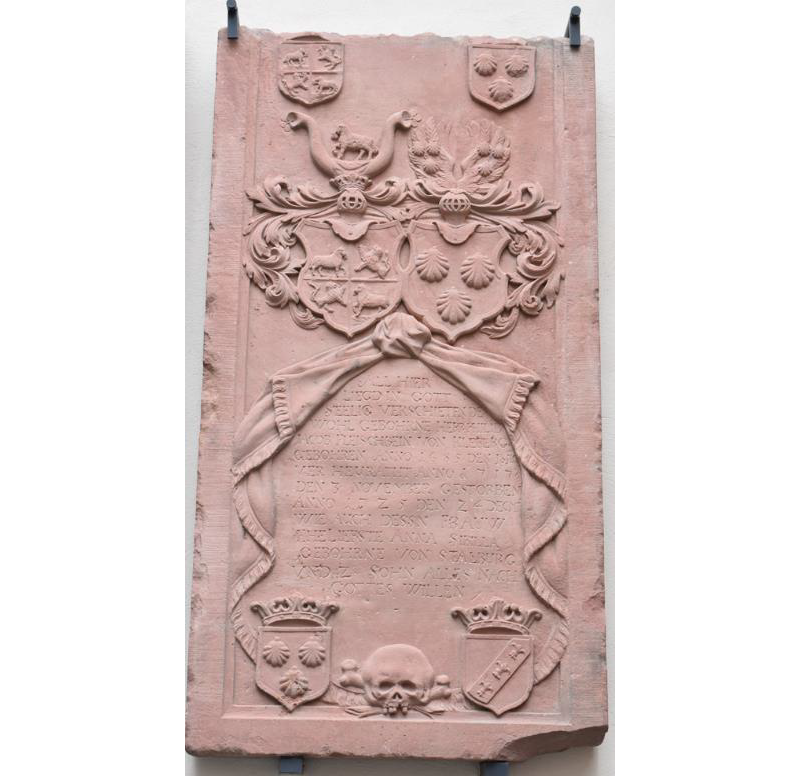
The red sandstone gravestone shows two large coats of arms with helmet ornaments above an inscription framed by a cloth. The inscription reads translated:
All HERE LYING IN GOD
BLESSED DIFFERENT THE NOBLE BORN MR. PHILIB
JACOB FLEISCHBEIN VON KLEBERG
BORN 1685 THE 18 JUNE
MARRIED 1717
DIED NOVEMBER 3
IN THE YEAR 1725 THE 24 DECEMB
AS WELL AS HIS WIFE
ANNA SIBILLA
BORN VON STALBURG
AND 2 SONS EVERYTHING IN
GOD'S WILL
The coats of arms with elaborate helmet decorations are those of the deceased couple Philipp Jacob Fleischbein von Kleeberg (1685-1725) and his wife Anna Sibilla née von Stalburg (1686-1731). The quartered coat of arms of Fleischbein von Kleeberg shows two lambs with a cloverleaf in their mouth and two rising lions with a cloverleaf in their paws. The coat of arms of the von Stalburg shows three scallops. The coats of arms in the four corners of the plate are those of the parents of the couple (Fleischbein v. Kleeberg, v. Stalburg and Baur v. Eysseneck). The couple had two sons, Johann Christoph Fleischbein (1718-1731) and Philipp Carl Fleischbein (1720-1724).
Niche 7 - Portal lintels
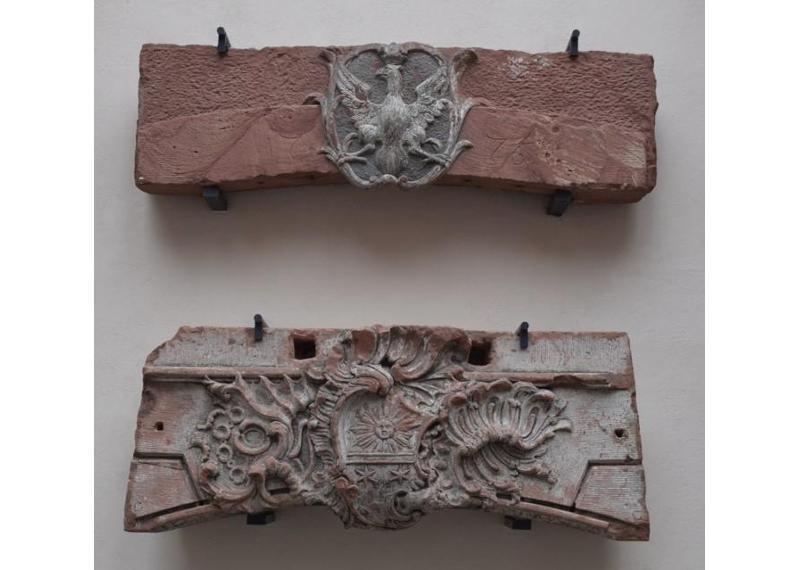
Portal lintel stone, 1776
Institution for Epileptic Kastenhospitalgasse 7/9
The rectangular lintel stone consists of red sandstone. The stone with the Frankfurt eagle and the date 1776 was originally located above the portal of the main entrance of the "Kastenspital". Around 1600, the city had built the "Tollhaus" (madhouse) in Tollhausgasse (today's Börsenstraße) near the Rahmhof for the mentally ill, who used to be called "Blödsinnige ("idiots")" or "fools". The Allgemeine Almosenkasten, a public charitable foundation from 1531, was responsible for the care and nursing of the sick. A new building was erected on the site in 1777/1785 and named "Kastenhospital". The patients were visited by a doctor three times a week. A nursing ward for epileptics was established in 1819, and in 1833 the hospital was given the name "Institution for the Insane and Epileptic".
Portal lintel stone, 1748
Former "Schmid's House", Schnurgasse 36
The rectangular lintel stone consists of red sandstone. Above the round arch it shows a rocaille with sun and two stars in the middle surrounded by a decorative rim with chain links. The stone was located above the entrance portal of the so-called Schmid's house in the central axis of the building front (in the photo the narrow doorway in the left half of the picture).
The banker Johann Friedrich Schmid (1703-1767) had the palace in Schnurgasse built in 1748 for 45,000 gulden. He died at the age of 64 and was considered one of the most successful bankers of the 18th century in Frankfurt am Main. At his death in 1767 he was the richest banker in the city.
Niche 8 - Atlases and putti
Corbels with Atlas and Putti figures, around 1730
"Reineck's house" in Hasengasse
The stones in this niche originate from the former Reineck house on Hasengasse. The baroque building with its garden was one of the most magnificent estates in Frankfurt. In 1848 it was used as barracks, and demolished in 1879. Like his father, Friedrich Ludwig von Reineck (1707-1775) was a wine merchant in Frankfurt am Main. He was ennobled in 1729.
Niche 9 - eagle stones

Eagle tablet, 18th century (?)
Former Gallustor
The oval coloured sandstone slab is decorated with a frame strip and shows the Frankfurt Eagle with crown and an "F" on the chest in the middle. It comes from the Gallus Gate and has been in the museum since 1895. The Gallus Gate was renovated in 1809 and the stone was removed from the gate in 1864. The Galgentor, also called Gallus-Tor (Gallus Gate), was one of five city gates of the late medieval city fortifications. The gate was built between 1281 and 1392 and was demolished in the 19th century.
Eagle tablet, 1727
Old city wall, behind the Töngesgasse
This stone is made of basalt and shows the Frankfurt eagle with the date 1727, which, according to the museum's inventory map, is marked "Old city wall facing the former moat, opposite the current market hall". According to the entry, several such eagle stones were embedded in the Old City Wall, which adjoined the rear buildings of Töngesgasse. Another preserved eagle stone with the date 1712 has been reinstalled in another place. The sandstone block is now located in the Staufer wall at the passage near the Fahrgasse.
Eagle tablet, 19th century
Kaiserdom, Cathedral Square 1
The rectangular stone tablet shows in high relief a crowned eagle with outstretched wings. The plaque comes from the imperial cathedral. There it was located in the eastern basement of the tower, as a centrepiece in the ledge of a balustrade of the former organ gallery. It was installed between 1869 and 1880 after the cathedral fire (1867) by master builder F. J. Denzinger. The balustrade was removed in 1950/1953 in the course of reconstruction by the architects H. Mäckler and A. Giefer.
Portal lintel stone with eagle motif, 18th century
Seehofquelle (Sachsenhausen), former crowning of the fountain room
This block of red sandstone shows a crowned eagle with outstretched wings in the middle of an oval framing, to the sides of which lush plant ornaments entwine. It comes from the former crowning of the fountain room of the Seehofquelle in Sachsenhausen. The grounds of the associated park have been owned by the city of Frankfurt am Main since 1842. The Seehofpark has had a chequered history in the past thanks to a spring on site which was collected in 1857. Fish ponds are known from the beginnings. Later a manor house was built there and in 1859 waterworks were put into operation. The water was used by breweries, market gardens and the municipal abattoir. Today the water from the spring is used as service water for the Deutschherrnviertel. In 1911 the area was established as a public park and opened to the public.
Niche 10 - Capitals
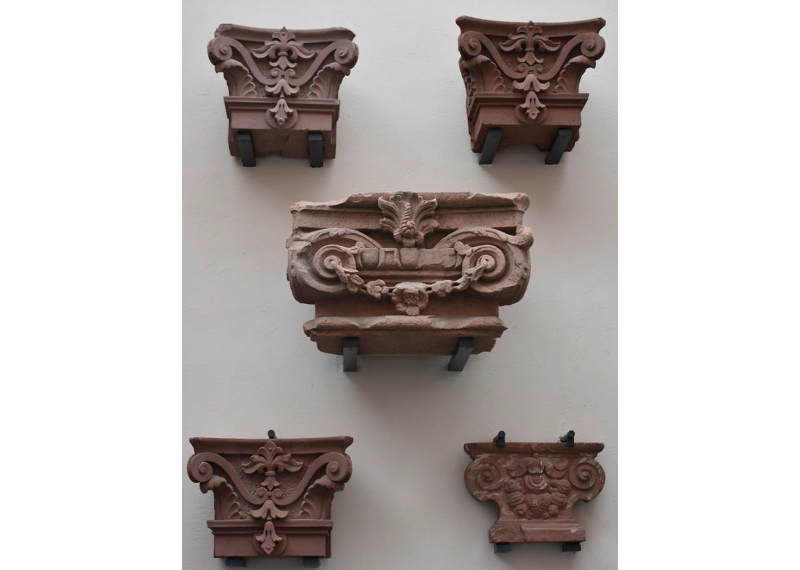
Corinthian pilaster capital, probably 19th century.
Origin unknown
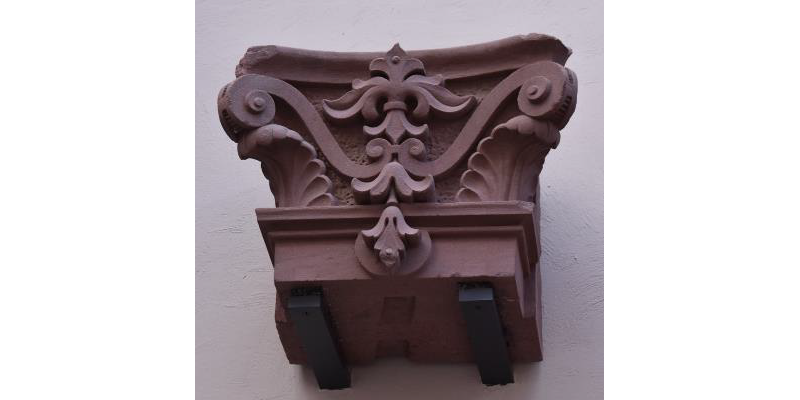
This Corinthian pilaster capital probably dates from the 19th century and was machine-made. The origin of the stone is still unknown.
Pilaster capital 1753-1757
Darmstadt Court, Zeil 46
This ionic pilaster capital consists of red sandstone. The stone decorated with a flower tendril comes from the Darmstädter Hof (Darmstadt court). The spacious Darmstädter Hof building had been owned by the Hessian-Darmstadt royal family since 1627 and served as the city residence of the landgraves of Hesse-Darmstadt. After demolition in 1899, the M. Schneider department store was initially located on the property. After the Darmstadt court was demolished, the city bought the decorative stones of the baroque street and courtyard facades in order to rebuild the building later in another location. The stones were stored for years in the Frankfurt city forest and, pushed together, served as a rock landscape in an animal enclosure.
Pilaster capital, 18th century.
Origin unknown

This red sandstone pilaster capital shows a frugal motif between twisted volutes. The origin of the stone is still unknown. Due to the flat design of the pilaster capital, the stone could be a stove stone. Such stove stones served as feet for cast-iron stoves and were widely used in the 18th century.
Niche 11 - lunettes with fish
The three bezels in a segmental arch are made of red sandstone. They each show two fantastic fish with crossed fins. The stones come from the house Domplatz 8 and were placed there as arched fields above the windows on the first floor. The classicistic building was designed by the architect Philipp Jacob Hoffmann (1772-1834), the father of the physician Dr. Heinrich Hoffmann (1808-1894). A bookstore had its business premises in the building. In 1762 J.W.A. Jaeger acquired the "Hutterische" bookshop on the Pfarreisen (cathedral square), founded around 1690, for the sum of 11000 gulden. His sons continued the business. Later the company Betten-Brehler took over the premises.
Niche 12 - lunettes with birds of prey
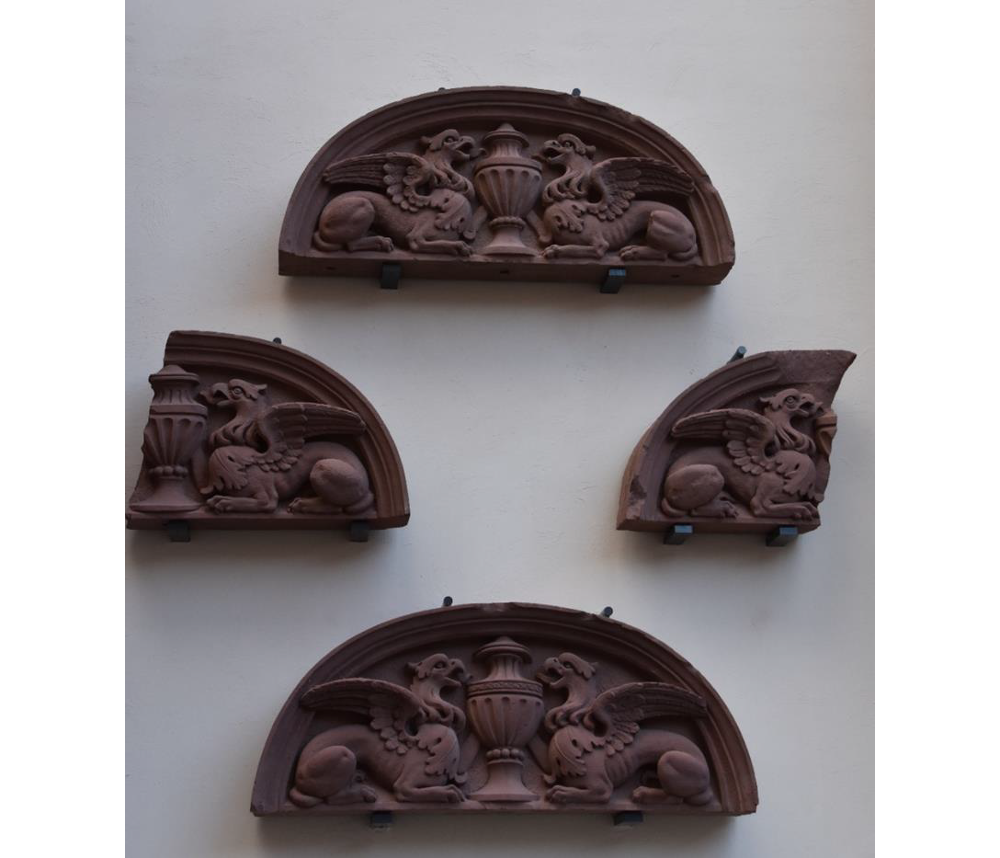
The three bezels in segmental arch form presented here, of which the middle one is broken in two, also originate from Domplatz 8, for details see the text on niche 11.
Based on texts and photographs by Bernhard Eddigehausen, further thanks to Dr. Andreas Hansert.

